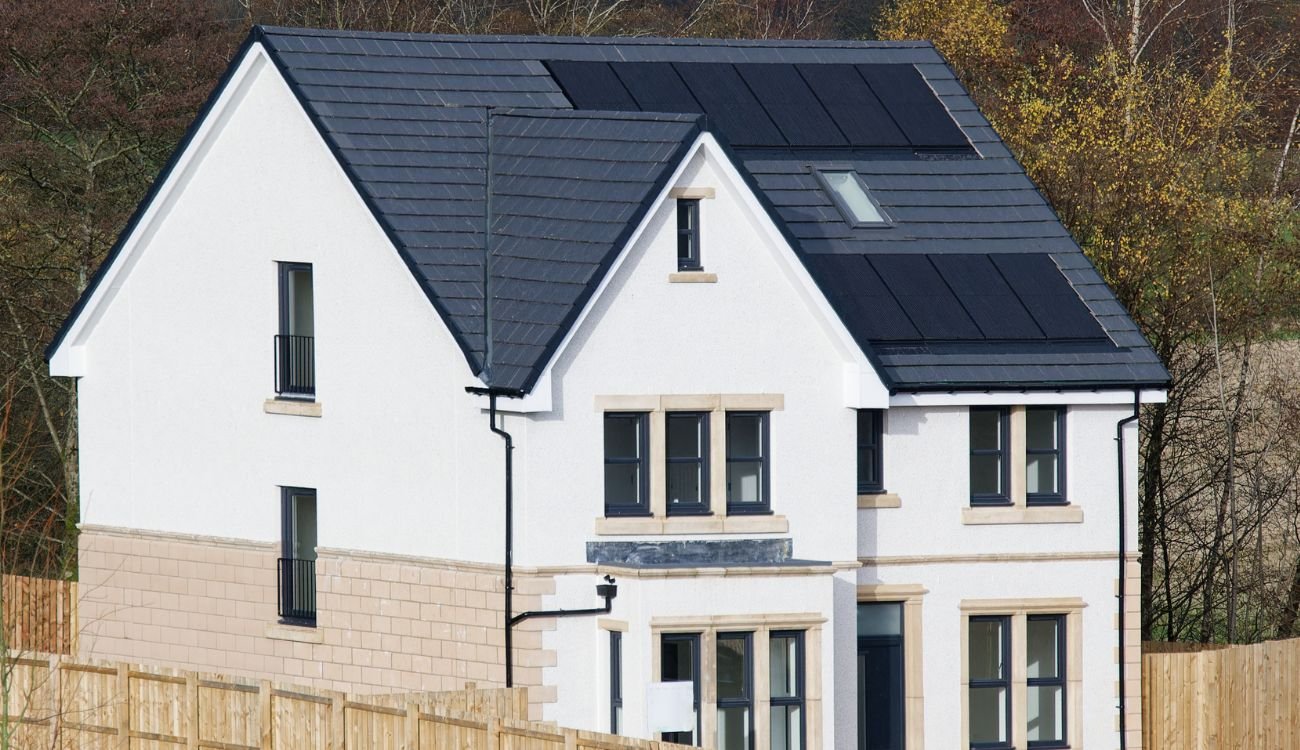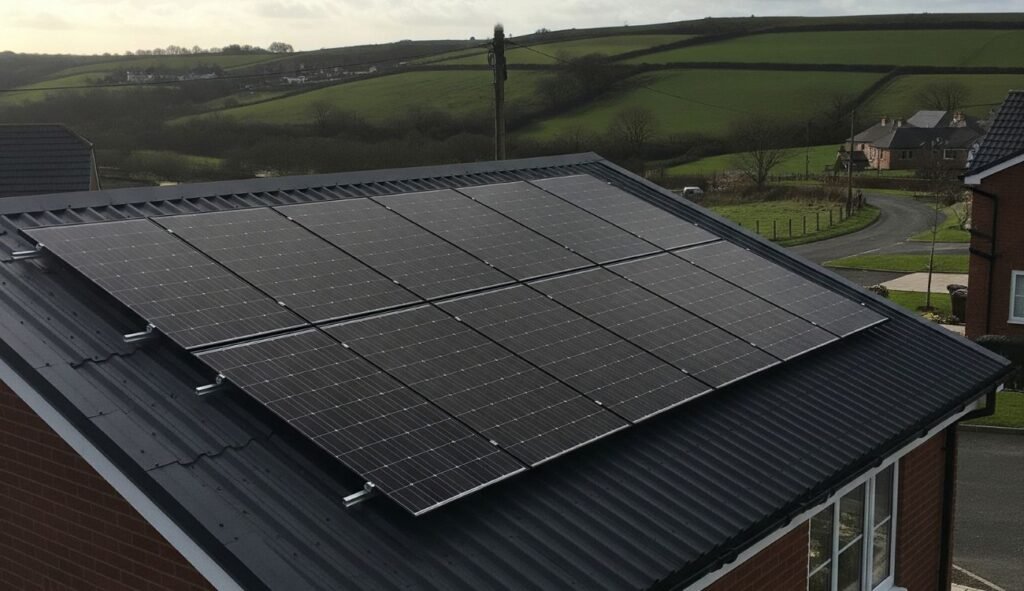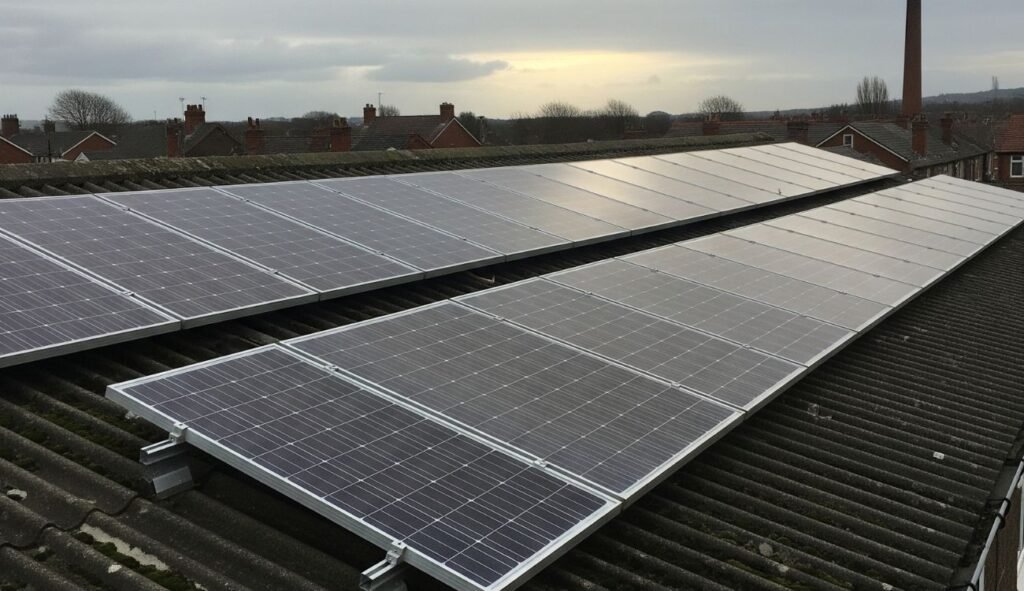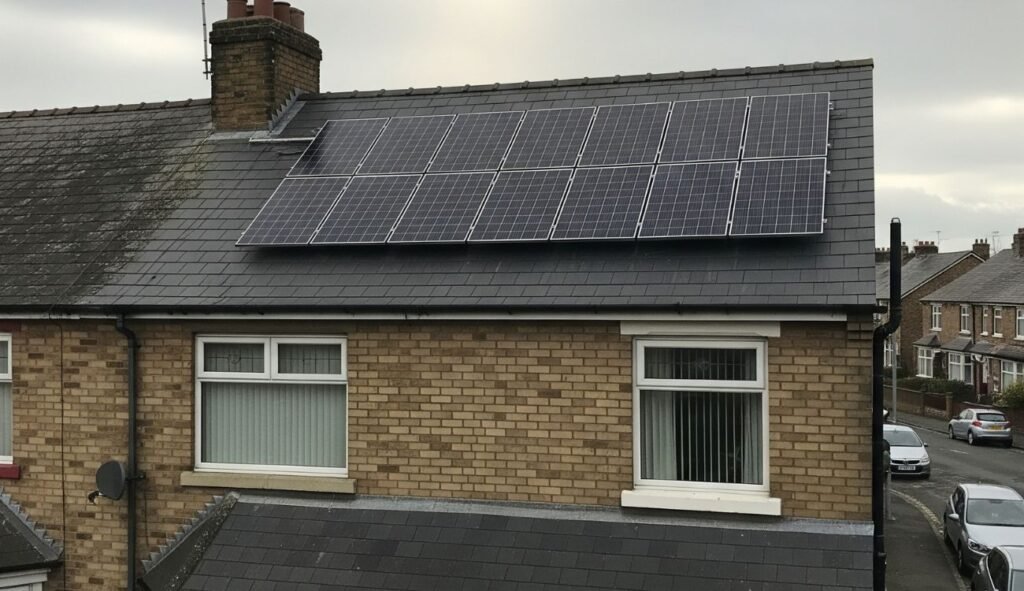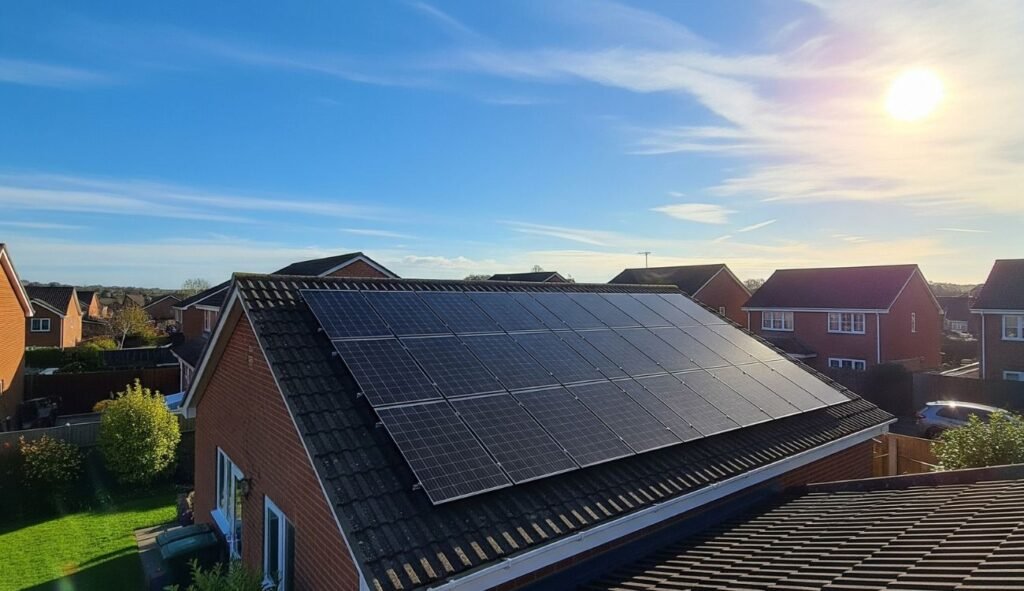Understanding how much electricity a 400-watt solar panel produces is essential if you’re weighing up the benefits of solar energy in the UK.
Whether you’re a UK homeowner aiming to cut energy bills, a landlord working towards EPC compliance, or a commercial business pursuing sustainability targets, understanding solar panel output is crucial to planning your investment.
In this expert guide, we’ll explore how much energy a 400W solar panel can generate in UK conditions, what that means in real-world savings, and how it compares across residential and commercial setups.
We’ll also look at key entities like Ofgem, the Smart Export Guarantee, and Energy Performance Certificates (EPCs) to show how solar fits into the broader UK energy landscape.
Let’s unpack the value, performance, and practical impact of 400W solar panels so you can make a confident, well-informed decision.
How Much Electricity Does a 400-Watt Solar Panel Generate?
On average, a 400-watt solar panel in the UK produces between 1.2 and 1.6 kilowatt-hours (kWh) of electricity per day. This depends on:
- Location: Southern England gets more solar irradiance than Scotland.
- Time of year: Summer months can yield up to 2.5 kWh/day; winter may drop to 0.5 kWh/day.
- Orientation and tilt: South-facing roofs tilted at 30–40° are ideal.
- Shading and weather: Cloudy days and shaded areas reduce output.
Real-world UK example:
- In London, a 400W panel typically produces ~1.4 kWh/day annually.
- In Newcastle & the North East, it’s closer to ~1.2 kWh/day due to lower solar irradiance.
How much electricity can one 400W panel generate per year?
In the UK, a single 400-watt solar panel generates approximately 365 to 550 kWh/year.
- Low end (cloudier regions or less ideal orientation): ~365 kWh.
- High end (sunny areas with optimal installation): ~550 kWh.
Solar panels produce clean electricity all year round, even in cloudy conditions.
Is a 400W Solar Panel Enough to Power a Home?
Not on its own. While 1.4 kWh/day can power:
- A laptop for 10 hours/day.
- An LED TV for ~5 hours/day.
- Or charge a phone over 100 times.
…it’s not enough for high-demand appliances like washing machines, kettles, or ovens. However, multiple 400W panels can power significant portions of your home’s needs.
Want more details? Read our guide on what appliances solar panels can power based on your system’s output and energy usage.
Typical UK household electricity use:
- The average household uses 2,900–3,500 kWh/year (Ofgem).
- You’d need around 8 to 10 panels (3.2–4 kW system) to offset most of that usage, , but before deciding, it’s worth checking how many solar panels you can fit on your roof based on available space and panel dimensions.
For most homes, 400W would be enough to power multiple appliances at once, whereas the list of appliances you can power with a 100W solar panel is much smaller and wouldn’t be powered for as long.
How does this translate into cost savings?
Assuming 10 panels (4kW system) generating ~4,000 kWh/year:
- At £0.30 per kWh (typical UK rate), that’s £1,200 in annual savings.
- Combine that with SEG payments for exported energy to further increase ROI.
Ready to see how much you could save with solar?
Get a free, no-obligation solar panel quote from Future Heat today, proudly serving Newcastle, Tyne and Wear, and the North East with MCS-certified installations.
How Do 400W Panels Compare with Other Solar Options?
| Panel Size | Power (W) | Output/day (UK avg) | Area Required | Suitability |
|---|---|---|---|---|
| Small | 250W | ~0.8–1.0 kWh | Smaller | Flats, small rooftops |
| Medium | 400W | ~1.4–1.6 kWh | ~2 m² | Most homes & businesses |
| Large | 500W+ | ~1.8–2.2 kWh | Larger area | Commercial roofs, ground-mount setups |
Is a 400W Solar Panel Suitable for Landlords and EPC Compliance?
Yes, 400W solar panels can play a valuable role in helping landlords meet UK Energy Performance Certificate (EPC) requirements. While one panel alone won’t dramatically shift a property’s rating, when installed as part of a small solar array, they can significantly reduce a building’s carbon footprint and improve energy efficiency.
This not only aids in meeting Minimum Energy Efficiency Standards (MEES) but also enhances tenant appeal and property value.
Why do landlords invest in solar?
Solar panels help improve EPC ratings, which are mandatory for rental properties in the UK. Properties with higher EPC ratings:
- Attract better tenants.
- Command higher rents.
- Avoid fines under the Minimum Energy Efficiency Standards (MEES).
A 400W panel on its own won’t be transformative, but as part of a small solar array:
- It contributes to energy efficiency improvements.
- Reduces tenants’ utility bills.
- Qualifies for green grants (if combined with insulation or heat pumps).
What About Commercial Applications of 400W Panels?
For UK businesses, 400W solar panels offer a cost-effective and scalable way to lower operational energy costs and meet sustainability objectives.
Their higher wattage per panel makes them ideal for larger rooftop installations, helping commercial properties reduce reliance on the National Grid and protect against energy price volatility. These panels can deliver impressive ROI when deployed in volume and are eligible for various tax reliefs and clean energy incentives.
How do businesses benefit from 400W panels?
Commercial properties typically install solar arrays on a kilowatt or megawatt scale, using 400W+ panels for:
- Reducing overheads: Lower electricity bills by up to 60%.
- Improving sustainability: Meet corporate social responsibility targets.
- Tax benefits: Eligible for capital allowances and business grants.
What Factors Affect the Output of a 400W Solar Panel?
Several environmental and installation variables influence how much electricity a 400W solar panel produces in the UK. These include geographic location, roof orientation, shading, temperature, and even the cleanliness of the panels.
Understanding these factors helps ensure optimal system performance and accurate forecasting of energy production, which is critical for calculating savings and return on investment.
On top of that, choosing a qualified solar panel installer is just as important and can help you avoid costly mistakes and ensure maximum long-term efficiency.
1. Roof orientation and pitch
- South-facing: Best performance
- East/West-facing: ~10–20% lower output
- Flat roofs: Require angled mounting for optimisation
2. Shading
- Chimneys, trees, and nearby buildings reduce efficiency
- Consider micro-inverters or optimisers to minimise shading losses
3. Maintenance and cleanliness
- Dirt, bird droppings, and moss can cut output by 5–10%
- Regular cleaning = consistent performance
4. Temperature
Panels work better in cooler climates. High UK temps (rare) can slightly reduce efficiency—this actually makes the UK’s moderate climate advantageous.
What Are the Best Uses for a 400W Solar Panel in the UK?
400W solar panels are versatile and well-suited to a wide range of UK property types. Their high output per square metre makes them ideal for homes with limited roof space, landlords looking to boost EPC ratings affordably, and commercial buildings aiming to offset large-scale electricity use.
Whether you’re installing a few panels on a terraced house or hundreds on an industrial unit, 400W modules offer excellent performance and flexibility.
Ideal scenarios:
- Homeowners with limited roof space seeking high efficiency
- Landlords adding 2–4 panels to boost EPC scores
- Commercial units installing dozens for bulk savings
Are 400W Solar Panels Worth It?
Absolutely, especially when combined into a system that meets your energy needs. They offer:
- High efficiency in a limited space
- Reduced reliance on grid energy
- Eligibility for the Smart Export Guarantee (SEG)
- Improved property value and EPC ratings
While one panel alone won’t run a home, it’s a powerful building block in an overall solar strategy.
Frequently Asked Questions (FAQs)
Yes, a 400W solar panel can charge a 12V or 24V battery, typically with the help of a charge controller. On a sunny day, it can generate enough power to fully charge a 100Ah battery in 4–6 hours, depending on conditions. If you’re considering storage, it’s worth learning what size solar battery you need to maximise efficiency and reduce reliance on the grid.
To fully offset a typical UK home’s electricity use (~3,000 kWh/year), you’d need around 8 to 10 400W panels, depending on your roof orientation, location, and shading. For a more tailored answer, check out our guide on how many solar panels you need based on your home’s specific usage.
Yes, they still generate electricity on cloudy days—typically 10–25% of their rated capacity. Output will be lower, but panels continue to produce power in diffuse light.
400W panels offer a strong balance of power and size, but efficiency depends on the panel type. Some 370W panels may be more efficient per square metre than bulkier 400W options. Always check the efficiency rating (%).
Most 400W panels require around 1.8 to 2.0 square metres. A 4 kW system (10 panels) would need approximately 18–20 m² of usable roof space.
Our Verdict
Investing in solar energy is no longer just a green choice — it’s a financially smart one. A 400W solar panel delivers a solid balance of efficiency and size, making it ideal for a variety of UK properties. While one panel won’t power an entire home or business, multiple units working together can significantly reduce grid reliance, lower energy bills, and contribute to EPC improvement and carbon reduction goals.
Whether you’re a homeowner looking to future-proof your energy supply, a landlord aiming to boost your property’s energy performance, or a commercial enterprise seeking to cut operating costs, 400W panels are a strong, scalable building block in any solar strategy.
Myles Robinson is a seasoned expert in the boiler and home improvement industry, with over a decade of experience. He is deeply committed to environmental sustainability, actively promoting energy-efficient heating solutions to help households reduce their carbon footprint. By combining industry expertise with a dedication to environmental responsibility, Myles continues to lead efforts in transforming home heating practices towards a more sustainable future.

